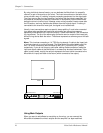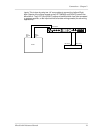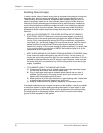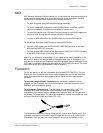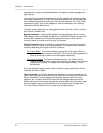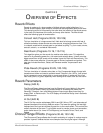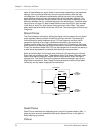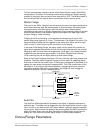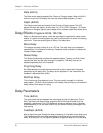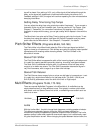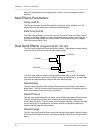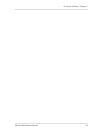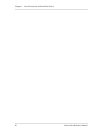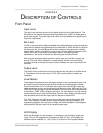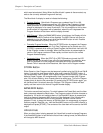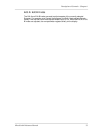
Chapter 3 – Overview of Effects
26 MicroVerb 4 Reference Manual
Rate (Edit A)
The Rate control sets the speed of the Chorus or Flanging sweep. When the Edit A
knob is turned, the LCD display will show the edited sweep frequency in Hertz.
Depth (Edit B)
The Depth control sets the intensity of the Chorus or Flanger sweep. The LCD
display will show the depth in a scale from 0 to 127 (0-125 for Flangers).
Tip:
Faster
Choruses or Flangers typically sound better with a shallower depth than slower ones.
Delay Effects (Programs 50-59, 150-159)
Delay is a discrete echo repeat, unlike the rapid wash of repeats that create reverb
effects. It is useful for adding depth to a track or performance if a reverb is muddying
up the mix. There are several types of Delay in the delay bank:
Mono Delay
This subtype provides a delay of up to 1270 ms. The delay time can be adjusted
separately by 10 millisecond increments. Feedback is also available to increase the
number of delay repeats.
Stereo Delay
This Single Configuration provides two separate delays. Typically, the Edit A knob
controls one side, and the other changes in proportion. The delay time can be
adjusted separately by 5 ms increments.
Ping Pong Delay
So called because the output bounces from left to right in stereo with the speed
determined by the delay time. The delay can be adjusted in 5 ms increments, and
feedback is adjustable from 0-99%.
MultiTap Delay
This is like having three delays at once. They are usually arranged in a rhythmic
delay pattern. The Edit A knob scales all of the delay times so that you can make the
delay rhythm fit the tempo of a song.
Delay Parameters
Time (Edit A)
This control sets the time between the input signal and the first delay tap. On the
Multi Tap Delay and Stereo Delay programs, the Edit A knob will scale all of the
delays by a percentage. The LCD display will show you the delay time in Seconds
and Milliseconds, or (in the case of Multi Tap and Stereo Delays) percentage of the
time scaling.
Feedback (Edit B)
After a signal has gone through the delay processing, it is fed back to the delay input.
The Feedback control sets what percentage of the signal will go back through the
delay. At a setting of 0%, no signal will go back through the delay, so only one delay



